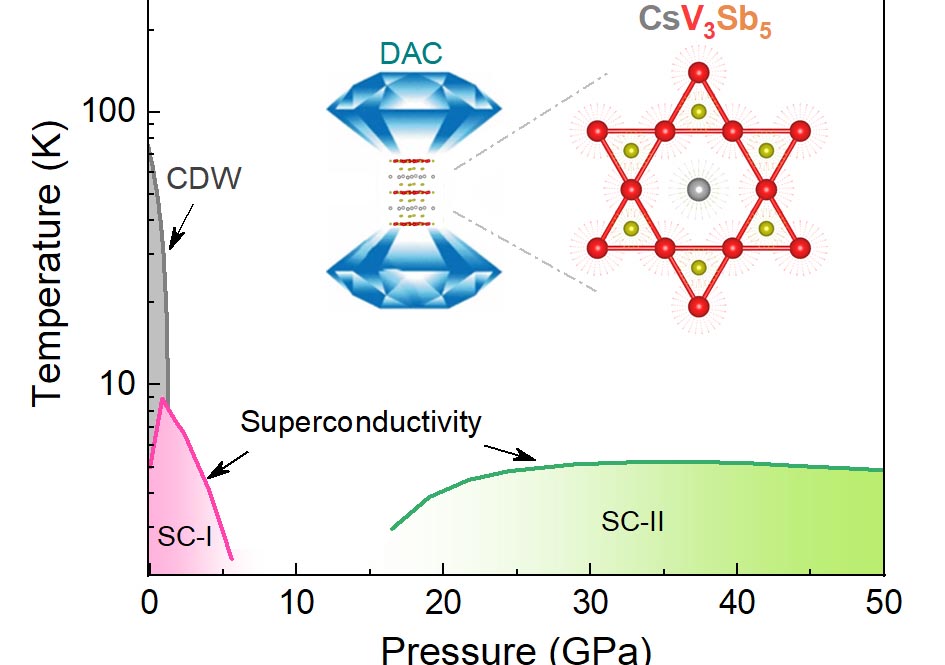Recently, a research team led by Prof. YANG Zhaorong from High Magnetic Field Laboratory, Hefei Institutes of Physical Science (HFIPS), in collaboration with researchers from Anhui University and other institutions, discovered pressure-induced two-dome superconductivity in the quasi-two-dimensional topological kagome superconductor CsV3Sb5. This work was published in Physical Review B, and selected as Editors’ Suggestion.
Owing to its unique geometry, the kagome lattice intrinsically hosts electronic flat bands (strong correlations), Dirac band crossings like in graphene, and Van hove singularities, enabling realizations of quantum diversities such as spin-liquid phases, intertwined collective orders. Recently, the kagome superconductors AV3Sb5 (A=K, Rb, Cs) have attracted much research interests due to discoveries of superconductivity, chiral charge effect, giant anomalous Hall effect, non-trivial topological electronic bands etc. Pressure, as one of the three fundamental thermodynamic parameters, is known as a clean and powerful means to directly manipulate the lattice and further tune the electronic states. Naturally, one may ask how these phenomena interact with each other and what kind of exotic states may emerge for the systems under pressure.
The team chose CsV3Sb5 as an example since it has the highest superconducting transition temperature TC ~ 5.0 K amongst the systems at ambient pressure. They used the so-called diamond anvil cell to generate high pressures up to 47.9 GPa. They found that TC first increases and then decreases rapidly under pressure, which is undetectable in the intermediate pressure range of 5-16 GPa; unexpectedly, superconductivity (SC) reemerges above 16 GPa, with TC first increasing slightly and then almost leveling off.
Therefore, a two-dome superconducting phase diagram is revealed for CsV3Sb5 under high pressure. In terms of the high-pressure synchrotron x-ray diffraction measurements, they found no any structural transition but an anomaly in ratio of the lattice parameters c/a just around the same critical pressure, indicating a Fermi surface reconstruction via Lifshitz transition that may be responsible for the reemergence of SC.
Many experiments suggest that the ambient-pressure SC in CsV3Sb5 should be unconventional. In this sense, this work evidences a two-dome SC in the first V-based unconventional superconductor. In addition to previous reports in tremendous unconventional superconductors like Cu-based, Fe-based, heavy-fermion systems, two-dome SC seems to be a common feature for these systems under external parameters, which may provide an important clue for understanding mechanisms of the unconventional SC.
This work was supported financially by the National Key Research and Development Program of China, the National Natural Science Foundation of China, the High Magnetic Field Laboratory of Anhui, as well as the Youth Innovation Promotion Association of CAS.
Link to the paper: Pressure-induced reemergence of superconductivity in the topological kagome metal CsV3Sb5

FIG. 1. Temperature-pressure phase diagram of kagome superconductor CsV3Sb5 (Imaged by CHEN Xuliang)
Contact:
ZHAO Weiwei
Hefei Institutes of Physical Science (http://english.hf.cas.cn/)
Email: annyzhao@ipp.ac.cn
 Tel: +86-551-65591206
Tel: +86-551-65591206
 Fax: +86-551-65591270
Fax: +86-551-65591270
 Emai: zhous@hfcas.ac.cn
Emai: zhous@hfcas.ac.cn
 350 Shushanhu Road
350 Shushanhu Road